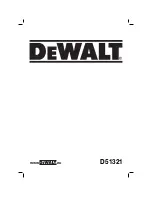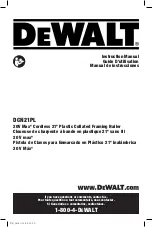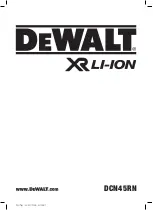
7
17. Always check the tool before use for broken,
misconnected or worn parts.
18. Do not overreach. Only use in a safe working place.
Keep proper footing and balance at all times.
19. Keep bystanders away (when working in an area
where there is a likelihood of through traffi c of people).
Clearly mark off your operating area.
20. Never point the tool at yourself or others.
21. Do not rest your fi nger on the trigger when picking
up the tool, moving between operating areas and
positions or walking, as resting fi nger on trigger can
lead to inadvertent operation.
For tools with selective actuation, always check the
tool before use to ascertain the correct mode is
selected.
22. Only wear gloves that provide adequate feel and safe
control of triggers and any adjusting devices. When
resting the tool, lay it down on the fl at surface. If you
use the hook equipped with the tool, hook the tool
securely on the stable surface
23. Do not operate when under the infl uence of alcohol,
drugs or the like.
24. Do not use the tool when you are on a scale,
stairs or scaffolds, ladders, or ladder alike
constructions, e.g. roof laths, when closing
boxes or crates, when fi tting transportation
safety systems e.g. on vehicles and wagons.
Projectile hazards
1. The fastener driving tool shall be disconnected when
unloading fasteners, making adjustments, clearing
jams or changing accessories.
2. During operation be careful that fasteners penetrate
material correctly and cannot be defl ected/ misfi red
towards operator and/or any bystanders.
3. During operation, debris from workpiece and
fastening/collation system may be discharged.
4. Always wear protective goggles to protect
your eyes from injury when using power
tools. The goggles must comply with ANSI
Z87.1 in the USA, EN 166 in Europe, or AS/
NZS 1336 in Australia/New Zealand. In Australia/New
Zealand, it is legally required to wear a face shield to
protect your face, too. It is an employer’s responsibility
to enforce the use of appropriate safety protective
equipment by the tool operators and by other persons
in the immediate working area.
5. The risks to others shall be assessed by the operator.
6. Be careful with tools without workpiece contact as
they can be fi red unintentionally and injure operator
and/or bystander.
7. Ensure tool is always safely engaged on the workpiece
and cannot slip.
8. Wear hearing protection to protect your ears
against exhaust noise and head protection.
Also wear light but not loose clothing.
Sleeves should be buttoned or rolled up. No
necktie should be worn.
Operating hazards
1. Hold the tool correctly: be ready to counteract normal
or sudden movements such as recoil.
2. Maintain a balanced body position and secure footing.
3. Appropriate safety glasses shall be used and
appropriate gloves and protective clothing are
recommended.
4. Appropriate hearing protection shall be worn.
5. Use the correct energy supply as directed in the
instruction manual.
6. Do not use the tool on moving platforms or back of
trucks. Sudden movement of the platform may lose
control of the tool and cause injury.
7. Always assume that the tool contains fasteners.
8. Do not rush the job or force the tool. Handle the tool
carefully.
9. Watch your footing and maintain your balance with the
tool. Make sure there is no one below when working
in high locations, and secure the air hose to prevent
danger if there is sudden jerking or catching.
10. On rooftops and other high locations, drive fasteners
as you move forward. It is easy to lose your footing
if you drive fasteners while inching backward. When
driving fasteners against perpendicular surface, work
from the top to the bottom. You can perform driving
operations with less fatigue by doing so.
11. A fastener will be bent or the tool can become jammed
if you mistakenly drive fastener on top of another
fastener or strike a knot in the wood. The fastener may
be thrown and hit someone, or the tool itself can react
dangerously. Place the fasteners with care.
12. Do not leave the loaded tool or the air compressor
under pressure for a long time out in the sun. Be sure
that dust, sand, chips and foreign matter will not enter
the tool in the place where you leave it setting.
13. Never attempt to drive fasteners from both the inside
and outside at the same time. Fasteners may rip
through and/or fl y off, presenting a grave danger.
Repetitive motions hazards
1. When using a tool for long periods, the operator may
experience discomfort in the hands, arms, shoulders,
neck, or other parts of the body.
2. While using a tool, the operator should adopt a
suitable but ergonomic posture. Maintain secure
footing and avoid awkward or off-balanced postures.
3. If the operator experiences symptoms such as
persistent or recurring discomfort, pain, throbbing,
aching, tingling, numbness, burning sensation, or
stiffness, do not ignore these warning signs. The
operator should consult a qualifi ed health professional
regarding overall activities.
4. The continuous use of the tool may cause repetitive
strain injury due to recoil produced by the tool.
5. To avoid repetitive strain injury, the operator should
not overreach or use excessive force. Additionally, the
operator should take a rest when feeling fatigue.
6. Conduct a risk assessment regarding repetitive
motion hazards. It should focus on muscular- skeletal
disorders and be preferentially based on the
assumption that decreasing fatigue during work is
effective in reducing disorders.
Accessory and consumable hazards
1. Disconnect the energy supply to the tool, such as
air or gas or battery as applicable, before changing/
replacing accessories such as workpiece contact, or
making any adjustments.
2. Use only the sizes and types of accessories that are
provided by the manufacturer.
3. Use only lubricants recommended in this manual.
































